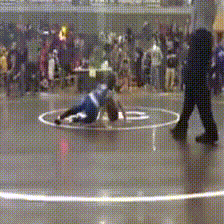Recognizing Violent Human Actions in Video
Projet Overview
Dataset
The dataset is a subset of the Kinetics dataset (include reference). Kinetics comprises a set of 400 general human action classes, each class having a total of 400 video samples in average, taken from YouTube videos. From this dataset, we created ViolentHumanActions_v2, comprising 20 classes, 9 of which are true violent actions, and the rest being non violent actions, but resembling violent ones. The non-violent actions were selected among the most frequent wrong predictions, when evaluating the model on the violent classes only.
| Violent Classes | Non-Violent Classes |
|---|---|
| punching person | punching bag |
| side kick | singing |
| high kick | playing squash |
| slapping | stretching arm |
| wrestling | soccer juggling |
| drop kick | playing cricket |
| sword fighting | kissing |
| headbutting | shaking head |
| capoeira | headbanging |
| . | tai chi |
| . | tango dancing |
The dataset has a train, valid and test split, each respectively accounting for roughly 80%, 15% and 5% of the whole dataset.
The dataset is located in /datasets/ViolentHumanActions_v2. It each split has a .csv file, each line starting by an action label, and the corresponding video filename.
ViolentHumanActions_v2
______________|________________
| | | |
data train.csv valid.csv test.csv
____|___________
| | |
train valid test
|_________________________
| | |
class_0 class_1 ... class_N
| |____________________
| |
videos for class_0 videos for class_1
Model architecture
The model is based on the i3D two-stream architecture (include reference), which uses a model trained on clips as sequences of RGB frames, and the other is trained on sequences of optical-flow frames. Both models are a 3D inflated variant of the Inception model (check official name of model). The mode is implemented in /models/i3d/i3d.py
Pre-processing
Since numerical arrays of uncompressed videos require much more space (rephrase), saving the dataset in RGB and optical-flow pre-processed format is unfeasible. Therefore, the dataset is made of compressed video files, and pre-processing is computed on-the-fly, as videos are loaded and fed to the network. See preprocessing.py for details on the pre-processing stage.
Setting up the project
Cloning the repository:
$ git clone https://github.com/simonguiroy/RecognizingViolentActions.git
Environment setup
-
Install Anaconda, if not already done, by following these instructions: https://docs.anaconda.com/anaconda/install/linux/
-
Create a conda environment using the
environment.yamlfile, to install the dependencies:
$ conda env create -f environment.yaml -
Activate the new conda environment:
$ conda activate RecognizingViolentActions
Getting the data
$ python download_dataset.py
Running experiments
Training the models
Models are trained by stochastic gradient descent. Default hyperparameters are
- learning rate: 0.001
- momentum: 0.9
- batch size: 5
- maximum number of frames per clip: 60 (this is a max value, since some clips may have fewer frames, even if clips have in average 250 frames)
All hyperparameters and other options are detailed parser.py.
The RGB and optical-flow models are trained independently, with each type specified by the --stream argument. Models are saved at every end of epoch in /out/i3d/saved_models, and training log files are saved in /out/i3d/logs/.
$ python train.py --stream rgb --num_epochs 1
Training can be resumed at a given epoch by using the --resume_epoch argument:
$ python train.py --stream rgb --resume_epoch 1
The project already contains checkpoints for the RGB and optical-flow models, pre-trained on Kinetics-400, and are saved under the names i3d_rgb_epoch-0.pkl and i3d_flow_epoch-0.pkl.
Testing the models
The rgb and optical-flow models are first tested indepedently. To test a model, specify the saved checkpoint. Testing results are saved in log files in /out/i3d/logs, and the model predictions are saved in out/i3d/preds.
To test the two stream joint predictions, the predictions of an RGB and an optical-flow model are averaged. To do so, specify the saved predictions of both the RGB and optical-flow model:
$ python test-joint --rgb_preds_path out/i3d/preds/preds_rgb_epoch-0.pkl --flow_preds_path out/i3d/preds/preds_flow_epoch-0.pkl --output_file joint-test_epoch_0.csv
Results
Demonstration of a video classification using averaged predictions:
| RGB pred: Dancing | Flow pred: Wrestling | Joint pred: Wrestling |
|---|---|---|
 |
 |
The following results show the top-1 testing accuracy using the RGB, optical-flow, and joint predictions. It also shows results after fine-tuning the RGB model on ViolentHumanActions_v2 for 3 epochs (using the default hyperparameters):
Testing accuracy:
| Model | Pre-trained on Kinetics | Fine-tuned |
|---|---|---|
| RGB-I3D | 0.6014 | 0.7210 |
| Flow-I3D | 0.6159 | - |
| Two-Stream I3D | 0.6630 | 0.7391 |